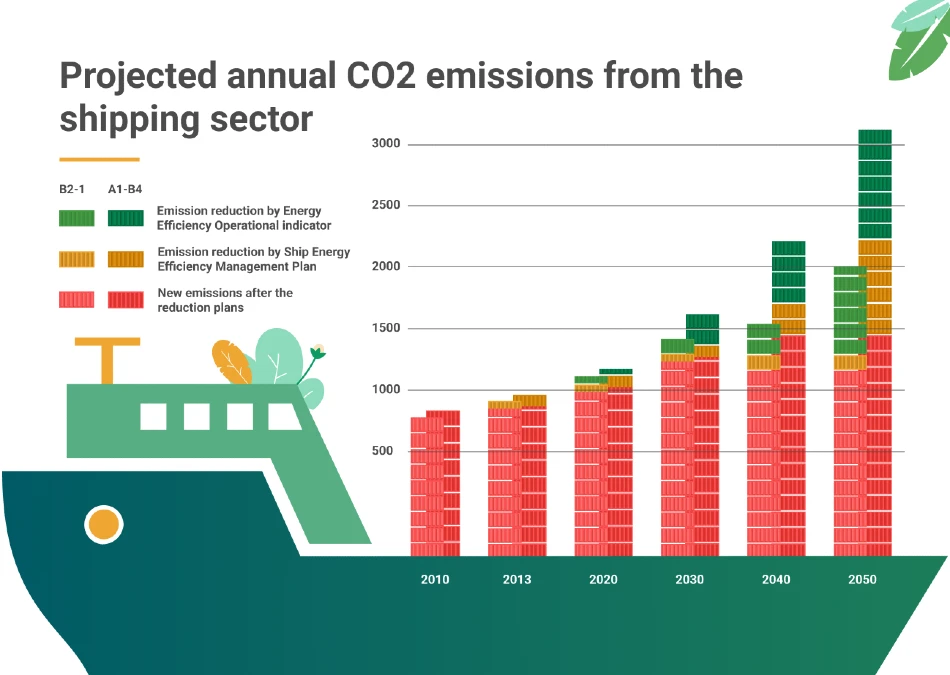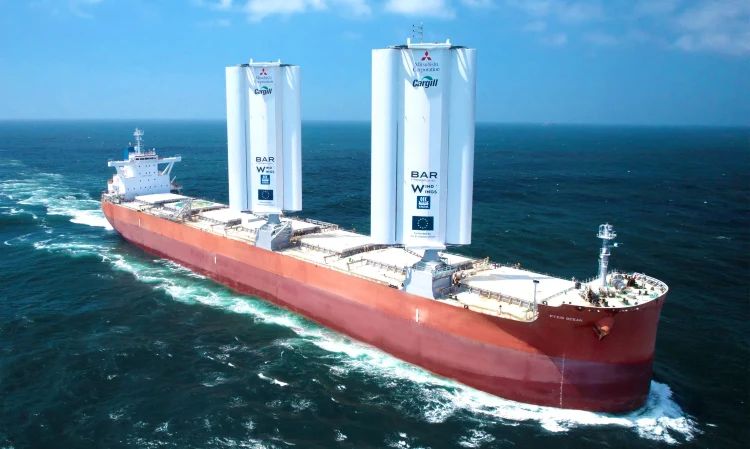A unique cargo ship, the Pyxis Ocean, is making waves in the maritime industry as it prepares to dock at the Polish port of Gdynia next week. Although it appears to be a typical dry cargo vessel, the Pyxis Ocean boasts a remarkable feature: two massive, rigid sails known as WindWings.
These towering 37.5-meter sails harness the power of the wind to assist in propelling the vessel, substantially reducing its reliance on fuel and contributing to carbon reduction efforts. Shipping is responsible for nearly 3% of global greenhouse gas emissions, making innovations like WindWings crucial.
The Pyxis Ocean embarked on its journey from Shanghai, China, on August 1, 2023, with a crew of approximately 20 members. It sailed to Paranagua, Brazil, in September, followed by stops at the Spanish island of Tenerife and, most recently, Poland. Notably, the WindWings were folded down during port stops along the way.
Jan Dieleman, President of Cargill Ocean Transportation, which chartered the Pyxis Ocean, revealed that the addition of WindWings aimed to reduce fuel consumption by around 20% during the voyage. However, Cargill’s calculations suggest that incorporating three WindWings on a new-build ship could potentially cut fossil fuel usage by up to 30%. If the vessel is powered by biofuels, this reduction could reach an impressive 50%.
In a significant commitment to sustainability, the maritime industry has pledged to achieve net-zero emissions by or around 2050. While wind power alone may not achieve this ambitious goal, technologies like WindWings offer a balanced approach, combining the reliability of engines with substantial fuel savings.
Despite the promise of green fuels like green methanol and green ammonia, which are more environmentally friendly but costlier than fossil fuels, WindWings offer several advantages. They reduce fuel volume by 30%, freeing up space for cargo instead of additional fuel tanks. This efficiency could lead to quicker paybacks on investments, making sustainable shipping more financially attractive.
Cargill has already ordered five methanol-powered bulk carrier vessels, the first of which was ordered in 2022, prior to the WindWings’ sea trials. Pending a successful evaluation of WindWings’ performance, Cargill intends to collaborate with shipyards to incorporate these sails into new vessel designs.

While the Pyxis Ocean’s voyage has seen smooth sailing overall, some ports expressed reluctance to accept the vessel due to its innovative technology. In the conservative maritime industry, adopting such innovations can be challenging and time-consuming.
WindWings, however, may not be suitable for all types of vessels. They’re best suited for bulk carriers like the Pyxis Ocean, which store goods, such as grain, inside cavities below deck. Container ships with multiple layers of large containers pose logistical challenges for implementing WindWings.
The development of WindWings is a collaborative effort involving Cargill, naval architect Bar Technologies, and Yara Marine Technologies, with the Pyxis Ocean owned by Mitsubishi Corporation. This initiative demonstrates the industry’s willingness to embrace innovation and take calculated risks to make a meaningful impact on reducing emissions in the maritime sector.

The Environmental Challenge of the Shipping Industry
The global shipping industry plays an indispensable role in our interconnected world, facilitating the movement of goods and materials that sustain our daily lives. The industry fills our shelves and makes it possible for us to order something we don’t really need on Amazon at 9pm and have it on our doorstep the next morning, before we forget what we ordered. However, this colossal industry also poses significant environmental challenges that affect us all.
The Environmental Impact Is Serious
- Greenhouse Gas Emissions: Shipping is responsible for nearly 3% of the world’s greenhouse gas emissions, primarily due to the massive engines and vast quantities of fuel required to propel these colossal vessels across oceans.
- Air Pollution: Beyond carbon dioxide (CO2), ships emit harmful pollutants like sulfur dioxide (SO2) and nitrogen oxides (NOx), contributing to poor air quality in port cities and impacting human health.
- Oil Spills: Accidental oil spills are infrequent but can have devastating ecological consequences when they occur, endangering marine life and coastal ecosystems.
- Ballast Water Discharge: Ballast water taken on by ships in one location and discharged in another often contains invasive species, disrupting local ecosystems.
The Energy Demands of A $14 Trillion Global Necessity
Global maritime trade is estimated to be worth over $14 trillion annually and is responsible for 80% of the world’s trade and employs millions of people. One can’t run those numbers without requiring some serious energy!
More To Discover
- Is SpaceX’s Starship as Green as It Seems? The Short Answer Is No.
- How The Propane Industry Spent $30M On A Greenwashing Campaign To Rebrand Itself As Sustainable
- Lab-Grown Oil: The Next Frontier in Sustainable Food Production?
- Musk Lied About Using Terminally Ill Monkeys at Neuralink; They Died Horribly
- Massive Fuel Consumption: Large cargo ships consume vast amounts of fossil fuels, with some of the largest vessels using as much fuel as a small town.
- Alternative Fuels: Transitioning to more sustainable fuels, such as biofuels or hydrogen, is challenging due to their higher cost and the need for substantial infrastructure changes.
- Technical Complexity: Retrofitting existing ships with cleaner technologies or designing new, environmentally friendly vessels involves complex engineering and considerable investment.
The WindWings Solution Has Potential
WindWings, as seen on the Pyxis Ocean, offer a glimpse into the future of sustainable shipping. By harnessing the power of the wind, they reduce industry’s heavy reliance on fossil fuels and emissions. These innovations symbolize the urgent need for greener shipping practices that can help protect our environment, mitigate climate change, and improve air quality in coastal communities.
While wind power alone may not fully achieve the goal of net-zero emissions in shipping, it represents a vital step toward reducing the industry’s carbon footprint. Combined with other eco-friendly technologies and cleaner fuels, advancements like WindWings offer a path to a more sustainable and environmentally responsible shipping sector.
Of course, there are still issues at play with the WindWings technology, similar to those in the wind energy sector, including the inevitable wind turbine waste. Unfortunately, we won’t know how the negatives stack up to the positives for a few more years.
In summary, the global shipping industry’s environmental and energy demands are substantial, impacting our planet and our lives in various ways. Innovations like WindWings hold promise in addressing these challenges and transforming shipping into a more eco-conscious and energy-efficient endeavor, benefiting us all in the long run.



















